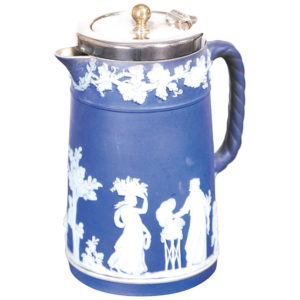 By Anne Gilbert
By Anne Gilbert Confusion reigns for the many beginning collectors of ceramic items. Much of my reader mail calls everything “china.” Actually they may be referring to one of the three major categories: earthenware, stoneware or porcelain. Each of these in turn break down into various techniques. For instance porcelain can be bone china, English soft past or Chinese hard paste. Earthenware can include Delft, creamware and slipware, each with their own individual characteristics.
Wedgwood offers a good example of how a name can be confusing. It could be any number of things from creamware to porcelain. Or, depending on the glaze or decorating techniques it could be the familiar Jasperware (a stoneware stained with metallic oxide in a variety of shades and with raised designs.” Or, a black stoneware known as Basalt. A Wedgwood piece with a tortoise-shell pattern and colors would be earthenware.
CLUES: The name porcelain comes from the Italian word “porcellana,” meaning cowry shell. It came to be named “china” because it was first made by the Chinese. Basically it is made of clay that is purified then baked to create a hard, translucent material. It evolved out of stoneware. Twang a piece that is supposedly porcelain with your finger. If it rings it is porcelain, fired at a high temperature.
Old faience, a tin -glazed earthenware also rings. No identity problem here. French, Italian and Spanish faience, made in the 17th and 18th centuries are heavy and have a crude appearance, looking more like earthenware, which they are.
You often hear pieces referred to as “hard paste” or “soft paste.” This is the material that the item is made of. Soft paste is more porous and dull, made from artificial clays. All Oriental china is hard paste.
Glazes offer another clue. They are the shiny material covering paste objects. “Hard glaze” is thin and colorless and feels cold to the touch. Soft glazes don’t have the cold feel and can be scratched with a knife. Another clue to identifying hard paste is the unglazed rings on the underside. Glazes can be applied by either spraying or immersion.
“Biscuitware” is unglazed white porcelain. Because it resembles white marble when glazed, it was used for sculptures that were popular in the 18th and 19th centuries.
“Bone china” is a translucent porcelain that is neither a true hard or soft paste. It contains Kaolin (fine white clay that fires pure white), petuntse (a feldspatic rock) and up to 40% bone ash. Invented by English potter, Josiah Spode, it has been made since 1800.
These are just a few of the many types of ceramics.















Follow Us